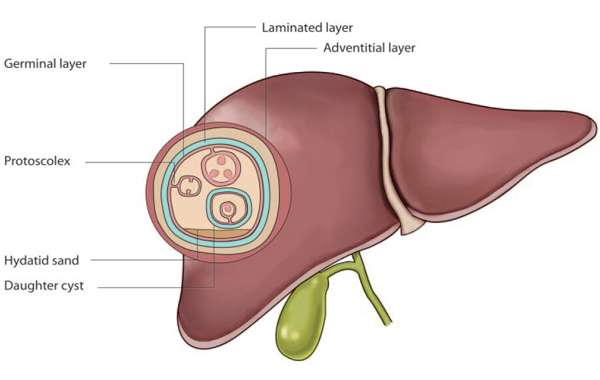Hydatid Cysts

Hydatid cysts (also called hydatidosis or echinococcosis) are parasitic infections caused by the larval stage of tapeworms from the genus Echinococcus. The most common species involved are Echinococcus granulosus (causing cystic echinococcosis) and Echinococcus multilocularis (causing alveolar echinococcosis). The infection primarily affects the liver and lungs, but other organs can also be involved.
Causes
Hydatid cysts are caused by ingesting eggs of the Echinococcus parasite, which are found in:
- Feces of infected animals (commonly dogs, wolves, foxes).
- Contaminated water, soil, or food.
- Close contact with infected animals.
Humans are accidental hosts, as they are not part of the parasite’s normal life cycle, which typically involves dogs as definitive hosts and livestock (like sheep) as intermediate hosts.
Symptoms
Symptoms depend on the size, location, and number of cysts and may not appear until the cysts become large enough to cause pressure on surrounding tissues. Common symptoms include:
- Liver involvement (most common site):
Abdominal pain
Nausea
Jaundice (yellowing of the skin/eyes, if bile ducts are obstructed) - Lung involvement (second most common):
Chest pain
Cough
Shortness of breath
Hemoptysis (coughing up blood) - Other organs: Cysts can form in the brain, spleen, kidneys, and bones, causing organ-specific symptoms like seizures, kidney pain, or bone fractures.
Diagnosis
- Imaging: Ultrasound, CT scan, or MRI to visualize cysts.
- Serology: Blood tests to detect antibodies against Echinococcus.
- Biopsy: In some cases, a cyst sample may be taken for examination, though this is rare due to the risk of cyst rupture.
Treatment
- Surgical removal: The main treatment for large or symptomatic cysts. Surgery involves removing the cysts without rupturing them.
- Percutaneous aspiration, injection, and re-aspiration (PAIR): Minimally invasive procedure where a cyst is punctured, injected with a scolicidal agent (to kill the parasite), and then re-aspirated.
- Antiparasitic medication: Albendazole or Mebendazole may be used, especially for smaller or inoperable cysts. These drugs inhibit the parasite’s growth but often require long-term use.
- Observation: In some cases, small cysts that are asymptomatic may be monitored over time with regular imaging.




